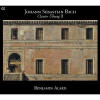Texte paru dans: / Appeared in:

Fanfare Magazine: 35:2 (11-12/2011)
Pour
s'abonner / Subscription information
Les abonnés à Fanfare Magazine ont accès aux archives du
magazine sur internet.
Subscribers to Fanfare Magazine have access to the archives of the magazine
on the net.
Alpha 180

Code-barres / Barcode:
3760014191800
Consultez toutes les évaluations recensées pour ce cd
~~~~ Reach all the evaluations located for this CD
The very first acquisition for any record collector seeking to build a library of harpsichord music should be Bach’s Clavier-Übung II. Published in Leipzig in 1735, it is Bach’s ultimate statement on the two prevailing styles of (secular) European music. At the very time that a bitter debate was raging in Paris on the relative merits of French and Italian music, German musicians such as Bach were embracing both styles by incorporating elements of Italian and French instrumental music into their works. Yet Bach went further than the rest; in the Italian Concerto, for example, he amalgamates the instrumental style of Corelli and Vivaldi with his own musical language, creating a one-of-a-kind piece that could never have been written by the likes of Telemann, Fasch, or Handel. Manfred Bukofzer calls Bach’s music “the fusion of national styles”, and the Italian Concerto is the perfect example of this. Aside from being tremendously exciting, BWV 971 is a pinnacle work of the Baroque that belongs in every library.
Prior to BWV 831, Bach had written many pieces in the French style, although he seldom used the characteristic double-dotted, bipartite ouverture as the opening movement. In the French Suites, for example, Bach typically begins with an allemande, in the English Suites with a prelude. The Fourth Partita, BWV 828, does begin with a grand ouverture, but this is a relatively isolated example. At 13 minutes, the opening Ouverture of BWV 831 is much longer than anything Bach had written previously in the form, a signal, perhaps, of how important this work was to him. The rest of the suite is filled with characteristic dances (gavotte, passepied, sarabande, bourée), many with doubles, although interestingly, there is no allemande. The work concludes with a Gigue and a joyous Echo; if the latter is played with proper spirit, it’s enough to get you up out of your chair and dancing around the room.
Benjamin Alard is a young French harpsichordist and organist who has a number of titles to his credit on the Alpha label. He has exactly one prior mention in Fanfare: Jerry Dubins called Alard’s recording of the partitas “the end-all and be-all” in 34:1. I haven’t heard that set yet (it’s on my “to-do” list), but I’m prepared to believe what Dubins says, because Alard’s playing on the present CD is very strong indeed. The watchwords are grace, precision, and a real sense of personality. For most recorded performances of the Italian Concerto, there exists a kind of consensus tempo in the outer movements; most performers, Alard included, cleave to the norm by adopting a healthy allegro and presto. The middle Andante is where the harpsichordist has an opportunity to make the performance his own. Alard plays the recurring bass motif (two eighth-note Ds) less ponderously than most; he does this by shortening the notes ever so slightly and inserting some daylight between them. The effect is perfect, because the music never stagnates, it moves along at a proper clip (the verb andare means, after all, to walk or move along). In BWV 831, all is well until the concluding Echo; Alard’s laid-back tempo here robs the music of a certain amount of drive and spark. It’s an interesting interpretative choice, but I refer the reader to the remarkable David Cates on Wildboar as an example of how outrageously exciting this piece can be in the right hands.
In Fanfare 34:2, I reviewed a Ramée CD with a similar program—Clavier-Übung II plus the Chromatic Fantasy and Fugue—played by another young Frenchman, Pascal Dubreuil. Equally impressive—in fact, if you were to compare passages from the two CDs side-by-side, I suspect the tempos and other interpretative details would match up quite well. Choosing between the two comes down to the instruments, and perhaps price and availability. Dubreuil’s harpsichord, a copy of a Ruckers mis à grand ravalement, is sonorous and ideally recorded. Alard’s instrument, a copy of an unspecified German original by Anthony Sidey, has a singing treble and a slightly acerbic bass, making Bach’s part-writing unusually clear. The engineering is equally good. You pays yer money and makes yer choice.
Cliquez l'un ou l'autre
bouton pour découvrir bien d'autres critiques de CD
Click either button for many other reviews


